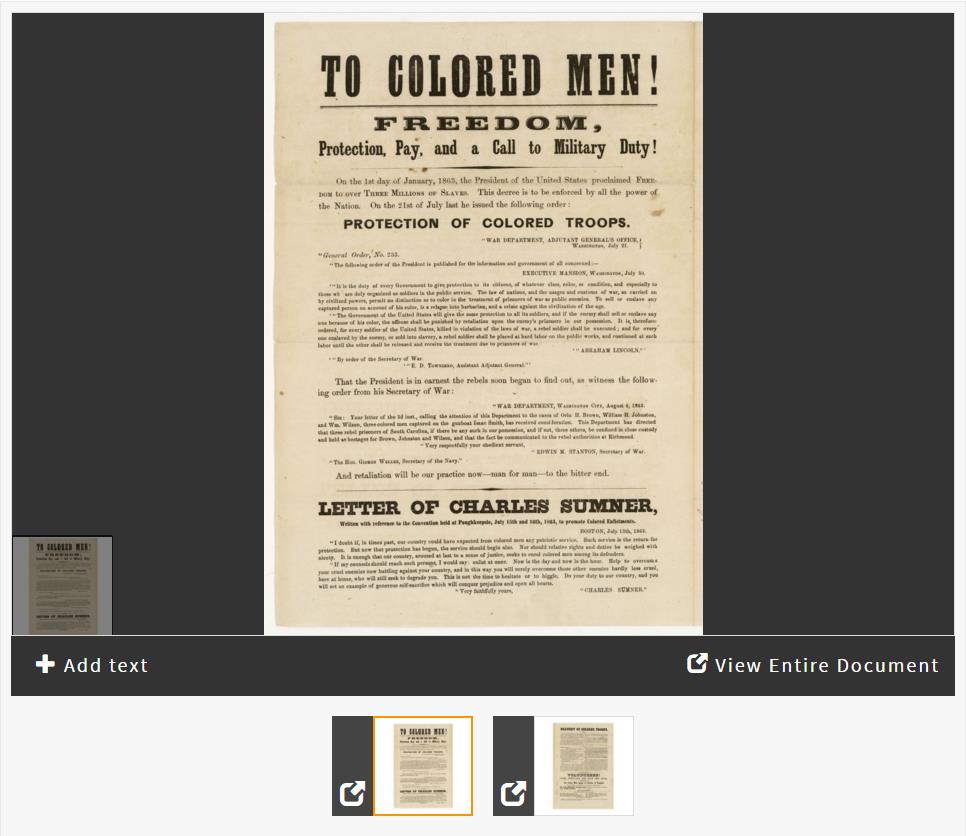In this activity students will analyze a two-page poster that the Government used to recruit recently freed slaves to fight for the Union Army during the Civil War. The poster refers to the Emancipation Proclamation and to President Lincoln's General Order 233 to provide equal pay for black soldiers and equal protection if they were captured by the Confederacy and became prisoners of war (POWs). They will learn how the U.S. Government tried to appeal to black soldiers and consider the importance of enlisting black soldiers to the Union's victory.
Use this activity while teaching about the evolving Federal position on emancipation and black recruitment during the Civil War, segregation and integration of the U.S. military, or a history of Civil Rights. For grades 7-10. Approximate time needed is 20 minutes.
This activity was adapted from an article formerly published on www.archives.gov/education and in the National Council for the Social Studies (NCSS) publication Social Education: Freeman, Elsie, Wynell Burroughs Schamel, and Jean West. "The Fight for Equal Rights: A Recruiting Poster for Black Soldiers in the Civil War." Social Education 56, 2 (February 1992): 118-120.
Suggested Teaching Instructions
Invite students to analyze this Civil War recruiting poster directed at black men.
Provide background information as necessary:By the end of the war, roughly 179,000 black men (10% of the Army) served in the Union Army, and another 19,000 in the Navy. Nearly 40,000 died. Black soldiers served in artillery, infantry, and noncombat support functions. Black carpenters, chaplains, cooks, guards, laborers, nurses, scouts, spies, steamboat pilots, surgeons, and teamsters also contributed. There were nearly 80 black commissioned officers. Black women could't formally join, but served as nurses, spies, and scouts—the most famous being Harriet Tubman.
But initially they were turned away, even though
news from Fort Sumter had set off a rush by free black men to enlist in the U.S. military. A 1792 Federal law barred them from bearing arms for the Army (although they had served in the American Revolution and in the War of 1812). The Lincoln administration wrestled with the idea of recruiting of black troops, concerned that it would prompt the border states to secede. When Gen. John C. Frémont in Missouri and Gen. David Hunter in South Carolina issued proclamations that emancipated slaves in their military regions and permitted them to enlist, their orders were revoked.
Increasing personnel needs pushed the Government to reconsider, however. Congress passed the Second Confiscation and Militia Act on July 17, 1862, freeing slaves with masters in the Confederate Army. Slavery was abolished in U.S. territories two days later, and on July 22 Lincoln presented the preliminary draft of the Emancipation Proclamation to his Cabinet. After the Union Army turned back Lee's first invasion of the North at Antietam and the Emancipation Proclamation was announced, black recruitment was pursued in earnest.
While serving, Black soldiers faced problems stemming from racial prejudice in addition to the perils of war. Discrimination permeated the military. White officers typically commanded black men in segregated units. Black soldiers were initially paid $10 per month, minus $3 for clothing, resulting in $7 net pay. White soldiers received $13 per month net. Congress granted equal pay to the U.S. Colored Troops in June 1864 and made the pay retroactive. Black soldiers received the same rations and supplies, and comparable medical care.
Black troops also faced greater peril than white troops when captured by the Confederate Army. In 1863 the Confederate Congress threatened to severely punish officers of black troops and to enslave black soldiers. Lincoln issued General Order 233, threatening reprisal on Confederate POWs for any mistreatment of black troops. This generally restrained the Confederates, but black captives were still treated more harshly.
Ask students to begin the activity, individually or in pairs:The Introduction will direct them to read both pages of the poster and click on "Add Text" in the bottom left corner to label any references they find to:
- pay,
- treatment of POWs,
- discrimination during the Civil War, or
- Government efforts to improve conditions for black soldiers.
When they click "When You're Done," they will be asked to answer the following questions:
- What did President Lincoln threaten to do in General Order 233 if the Confederacy treated a black prisoner of war like an escaped slave by selling or enslaving him?
- Besides offering pay and protection equal to white soldiers, how did the Government try to appeal to black soldiers? What argument did they use?
- How important do you think enlisting black soldiers was to the Union victory?
Discuss the answers as a class.





